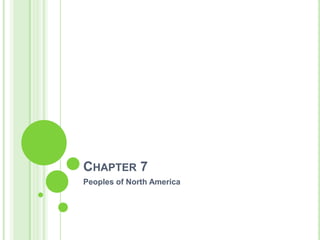
Chapter 7 Peoples of North America
- 1. CHAPTER 7 Peoples of North America
- 2. SETTING THE SCENE Climate and natural resources had profound effects on the daily life for the first people in North America The impact of the environment stretched far beyond the southwest Hundreds of cultural groups emerged in presentday United States and Canada Early people lived by hunting, fishing, and gathering The success of farming led to large populations and permanent settlements
- 3. EARLY TRIBES
- 4. THE DESERT SOUTHWEST---HOHOKAMS More than 1,000 years ago, fields of corn, beans, and squash bloomed in the desert southwest These crops were raised by the Hohokams (“Vanished Ones”) To farm the desert, they built complex irrigation systems The Hohokams lived near the Gila River in present-day Arizona They may have acquired skills such as irrigation from the civilizations of Middle America They built temple mounds and ball courts The Hohokams survived until about 1500 AD, when a drought forced them from their settlements
- 5. GILA RIVER
- 7. THE DESERT SOUTHWEST---ANASAZIS The best-known society of the southwest was that of the Anasazi They lived in what is known as the Four Corners region of Arizona, New Mexico, Colorado, and Utah Between about 900-1300 AD, the Anasazi built large villages called pueblos (named by the Spanish) Kivas (large underground chambers) were used for religious ceremonies Paintings on walls show their concern with weather, including storms that might damage crops
- 12. VISITING FOUR STATES AT ONE TIME!!!
- 13. ANASAZI PEOPLE
- 14. PUEBLO
- 15. PUEBLO
- 16. THE DESERT SOUTHWEST---ANASAZIS In the late 1100s, the Anasazi began building housing complexes in the shadow of canyon walls, where the cliffs offered protection from raiders The largest of these cliff dwellings at Mesa Verde, in present-day Colorado, had over 200 rooms People had to climb ladders to reach their fields on the flatlands above or the canyon floor below In the late 1200s, a long drought forced the Anasazi to abandon their land Attacks by Navajos and Apaches may have contributed further to their decline Anasazi traditions survive among the Hopis and other Pueblo Indians of the present-day southwestern U.S.
- 17. MESA VERDE
- 18. MESA VERDE
- 19. MESA VERDE
- 20. MESA VERDE
- 21. THE MOUND BUILDERS In the Mississippi and Ohio valleys, other farming cultures emerged as early as 700 BC The Adena and Hopewell peoples left behind giant earthen mounds The Mississippian people also built great earthen mounds Their greatest center, Cahokia in present-day Illinois, housed as many as 40,000 people by about 1200 AD Cahokia boasted at least 60 mounds
- 22. MAP OF MOUND BUILDERS
- 24. CAHOKIA MOUNDS
- 25. MOUND
- 26. CAHOKIA MOUNDS
- 27. DIVERSE REGIONAL CULTURES Modern scholars have identified 10 culture areas in North America based on the environments in which people lived: Arctic, Subarctic, Northwest Coast, California, Great Basin, Plateau, Southwest, Great Plains, Eastern Woodlands, and Southeast In each area, people adapted to geographic conditions that influenced their ways of life
- 28. A FROZEN WORLD In the frozen north, the Inuits (Eskimos) adapted to a harsh climate using limited resources of the frozen land to survive Seals and other sea mammals provided them with food, skins for clothing, bones for needles and tools, and oil for cooking The used kayaks in open waters or dog sleds to transport goods across ice Inuits also constructed igloos, or dome-shaped homes made from snow and ice
- 29. INUITS (ESKIMOS)
- 31. POLAR BEARS
- 32. IGLOOS
- 33. A LAND OF PLENTY The people of the Northwest Coast lived in a far richer environment than the Inuits Rivers teemed with salmon, and the Pacific Ocean offered other fish and sea mammals Hunters tracked deer, wolves, and bears in forests People built large, permanent villages with homes made of wood They traded surplus goods, gaining wealth that was shared at a potlatch At this ceremony, which continues in Canada today, a person of rank and wealth distributes lavish gifts to a large number of guests By accepting the gifts, the guests acknowledge the host’s high status
- 34. PACIFIC NORTHWEST TRIBES (WASHINGTON)
- 35. CANOE
- 36. WILD SALMON
- 37. GRILLED SALMON
- 39. THE IROQUOIS LEAGUE The Iroquois lived in the Eastern Woodlands, which stretched from the Atlantic Coast to the Great Lakes According to Iroquois tradition, the prophet Dekanawidah urged rival Iroquois nations to stop their constant wars Out of that grew the Iroquois League---an alliance of five nations who spoke the same language and shared similar traditions Member nations governed their own villages but met jointly in a council when they needed to address larger issues
- 40. DEKANAWIDAH
- 41. IROQUOIS LEAGUE